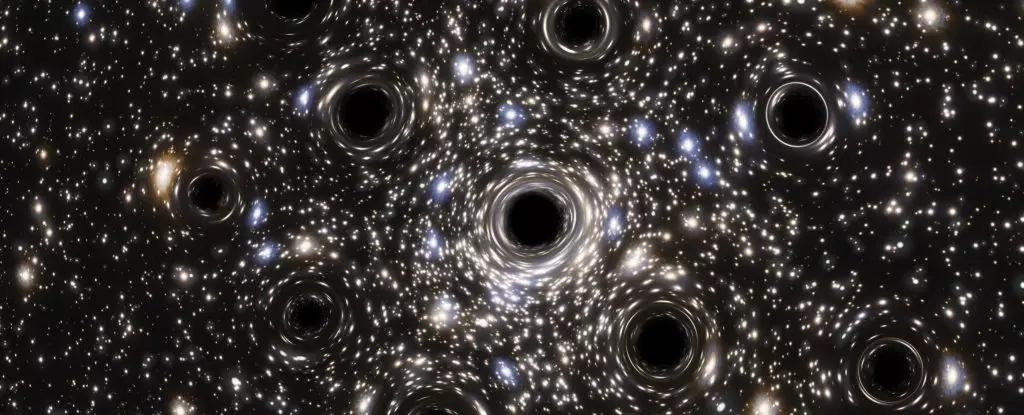In the vast expanse of the universe, certain clusters of stars captivate scientists with their potential to reveal cosmic secrets. One such celestial body is the Palomar 5 globular cluster, a sprawling stream of stars that stretches across a distance of 30,000 light-years and is situated about 80,000 light-years from Earth. This cluster is not merely a beautiful spectacle in the night sky; it serves as a significant piece in the puzzle of cosmic evolution and dark matter research. Recent investigations suggest that this cluster may harbor over 100 stellar-mass black holes, fundamentally reshaping our understanding of both black hole formation and star cluster dynamics.
Globular clusters like Palomar 5 are often likened to cosmic fossils, offering scientists a glimpse into the universe’s formative years. These dense, spherical collections of ancient stars, numbering in the hundreds of thousands, are relics from the early days of galaxy formation. For context, the Milky Way alone boasts more than 150 of these globular clusters. Each star within a globular cluster formed from the same primordial cloud of gas, creating a unique astrophysical environment for studying the underlying history of galaxies themselves. However, a new focus has emerged in astronomical research on tidal streams—elongated formations of stars trailing off from clusters—adding a layer of complexity to our understanding of galactic structures.
The Role of Gaia in Stellar Mapping
Traditionally, identifying tidal streams has been a significant challenge for astronomers. However, the advancements provided by the Gaia space observatory have revolutionized this field. Gaia has meticulously mapped the Milky Way in three dimensions, unveiling numerous stellar streams that were previously hidden from view. As physicist Mark Gieles points out, the formation of these streams is still a mystery, though one prevailing hypothesis suggests they arise from disrupted star clusters. Despite this theory, no confirmed associations between newly discovered streams and established star clusters had existed—until now, with Palomar 5 at the forefront of this exploration.
The unique characteristics of Palomar 5—the loose distribution of its stars and its extensive tidal stream—have compelled researchers to examine it more closely. Gieles and his team employed intricate N-body simulations to model the orbits and evolution of the stars within the cluster. Their findings revealed the possibility of a population of stellar-mass black holes residing within Palomar 5, which may have influenced the current configuration of stars seen today. Such gravitational interactions could facilitate a process where stars are flung out into the tidal stream, leading to a higher-than-expected number of black holes in the cluster, estimated to be around three times more than predicted.
Unveiling the Black Hole Population
This revelation changes the narrative surrounding the contents of Palomar 5. According to Gieles, black holes now constitute more than 20 percent of the total mass of the cluster, with each black hole having a mass approximately 20 times that of our Sun. This substantial presence of black holes is attributed to their formation during supernova events in the cluster’s youth, marking a stage of vigorous stellar evolution. The ongoing complexity of Palomar 5’s structure suggests not only a unique composition but also potentially provides a framework for understanding the lifecycle of similar clusters.
While studying the fate of Palomar 5, simulations indicate that in about one billion years, the cluster will disintegrate completely, eventually transforming into a stellar stream populated mainly by black holes. This forecast extends beyond Palomar 5; it suggests that many globular clusters will follow the same fate. The outcomes of these studies challenge previous assumptions about the permanence of star clusters and highlight the dynamic nature of the cosmos.
Implications for Black Hole Research
The implications of these findings stretch far beyond Palomar 5 itself. They present new opportunities to explore black holes in globular clusters, significant contributors to our understanding of binary black hole mergers. Fabio Antonini, an astrophysicist, emphasizes this potential; the research enriches our comprehension of how black holes evolve and merge in dense stellar environments. The mystery of how many black holes reside within star clusters remains an ongoing investigation due to the inherent invisibility of black holes. However, the Palomar 5 cluster offers an invaluable template for future studies on the gravitational interplay of stars and black holes in the universe.
As researchers continue to unlock the secrets held within clusters like Palomar 5, the knowledge gleaned from these investigations not only deepens our understanding of the cosmos but also paves the way for examining other stellar phenomena. The interplay between star clusters, tidal streams, and black hole formation reinforces the notion that the universe is a dynamic, ever-evolving realm, rich with mysteries just waiting to be explored.

